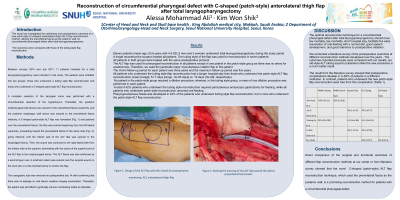Head and Neck Surgery
(502) Total Laryngopharyngectomy Reconstruction with C-shaped Anterolateral Thigh Flap
Monday, October 2, 2023
2:45 PM - 3:45 PM East Coast USA Time

Has Audio

Mohammed A. Alessa, MBBS,SBORL, MMed
consultant HEAD & NECK SURGERY and Microvascular REconstruction
Microvascualr Reconstruction
Jeddah, Saudi Arabia- WK
Won Shik Kim, n/a
Seoul National University Hospital, USA
Presenting Author(s)
Senior Author(s)
Disclosure(s):
Mohammed A. Alessa, MBBS,SBORL, MMed: No relevant relationships to disclose.
Introduction: This study investigates the usefulness and postoperative outcomes of a new patch-style (C-shaped) anterolateral thigh (ALT) flap reconstruction method, utilizing the prevertebral fascia as the posterior wall, for a circumferential pharyngeal defect after total laryngopharyngectomy.
Methods: Between January 2015 and July 2017, 11 patients who underwent a total laryngopharyngectomy were included in this study. The patients were stratified into two groups: a tubing-style flap reconstruction and a C-shaped patch-style ALT flap reconstruction. A complete resection of the laryngeal tumor was performed by total laryngopharyngectomy. In patch-style, the posterior oropharyngeal wall stoma was sutured to the prevertebral fascia superiorly, and the posterior esophagus wall stoma was sutured to the prevertebral fascia inferiorly and the Flap patched over the prevertebral fascia. The minim follow-up period for each patient was three years and the maximum follow-up period was five years.
Results: Eleven patients (mean age, 63.6 years with 4-5 SD; 8 men and 3 women). A single reconstructive surgeon treated all patients. The tubing used for reconstruction in seven patients. Tubing style Group had a longer hospital stay than patch-style (mean [range]: 51.7 days [range, 18–83 days] vs. 19 days [18–20], respectively). In the tubing style group, a mean of one dilation procedure was performed in each patient. A 42% tubing style patients required percutaneous endoscopic gastrostomy for feeding, while all patients who underwent patch-style reconstruction resumed oral feeding. Pharyngocutaneous fistula was developed in 42% of the patients who underwent tubing style flap reconstruction, but none of patch-style.
Conclusions: Direct comparison of the surgical and functional outcomes of different flap reconstruction methods at our centre or from the literature survey showed that the novel C-shaped (patch-style) ALT flap reconstruction technique, which used the prevertebral fascia as the posterior wall, is a promising reconstruction method for patients with a circumferential pharyngeal defect.
